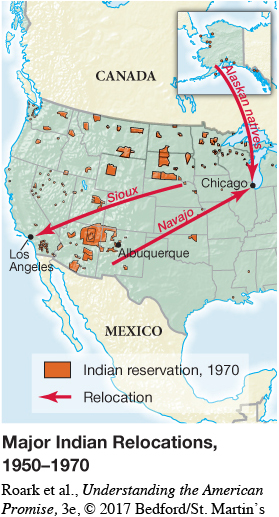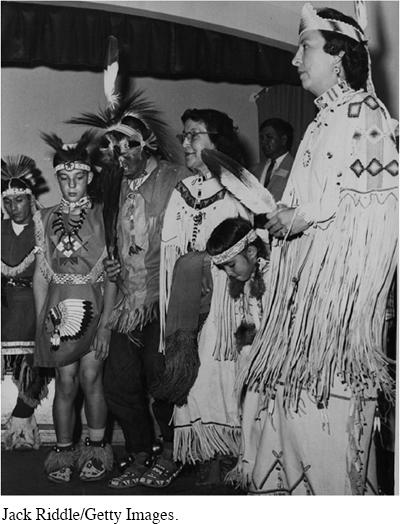Termination and Relocation of Native Americans
Eisenhower’s efforts to limit the federal government were consistent with a new direction in Indian policy, which reversed the New Deal emphasis on strengthening tribal governments and preserving Indian culture (see chapter 24). After World War II, when some 25,000 Indians had left their homes for military service and another 40,000 for work in defense industries, policymakers began to favor assimilating Native Americans and ending their special relationships with the government.
To some officials, who reflected Cold War emphasis on conformity to dominant American values, the communal practices of Indians resembled socialism and stifled individual initiative. Eisenhower’s commissioner of Indian affairs, Glenn Emmons, did not believe that tribal lands could produce income sufficient to eliminate poverty, but he also revealed the bias of policymakers when he insisted that Indians wanted to “work and live like Americans.” Moreover, Indians still held rights to water, land, minerals, and other resources that were increasingly attractive to state governments and private entrepreneurs.
By 1960, the government had implemented a three-part program of compensation, termination, and relocation. In 1946, Congress established the Indian Claims Commission to hear outstanding claims by Native Americans for land taken by the government. When it closed in 1978, the commission had settled 285 cases, with compensation exceeding $800 million. Yet the awards were based on land values at the time the land was taken and did not include interest.
The second policy, termination, also originated in the Truman administration when Commissioner Dillon S. Myer asserted that his Bureau of Indian Affairs should do “nothing for Indians which Indians can do for themselves.” Beginning in 1953, Eisenhower signed bills transferring jurisdiction over tribal land to state and local governments and ending the trusteeship relationship between Indians and the federal government. The loss of federal hospitals, schools, and other special arrangements devastated Indian tribes. As had happened after passage of the Dawes Act in 1887 (see “The Dawes Act and Indian Land Allotment” in chapter 17), corporate interests and individuals took advantage of the opportunity to purchase Indian land cheaply. The government abandoned termination in the 1960s after some 13,000 Indians and more than one million acres of their land had been affected.

The Indian Relocation Program, the third piece of Native American policy, began in 1948 and involved more than 100,000 Native Americans by 1973. The government encouraged Indians to move to cities, where relocation centers were supposed to help with housing, job training, and medical care. Even though Indians were moved far from their reservations, about one-third returned. [[LP Spot Map: SM27.01 Major Indian Relocations, 1950–1970/
Most who stayed in cities faced racism, unemployment, poor housing, and the loss of their traditional culture. “I wish we had never left home,” said one woman whose husband was out of work and drinking heavily. “It’s dirty and noisy, and people all around, crowded. . . . It seems like I never see the sky or trees.” Reflecting long-standing disagreements among Indians themselves, some who overcame these obstacles applauded the program. But most urban Indians remained poor, and even many who had welcomed relocation worried that “we would lose our identity as Indian people, lose our culture and our [way] of living.” Within two decades, a national pan-Indian movement—a by-product of this urbanization—emerged to resist assimilation and to demand much more for Indians (as discussed in “Native American Protest” in chapter 28). [[LP Photo: P27.03 Indian Relocation/

Understanding the American Promise 3ePrinted Page 770
Section Chronology